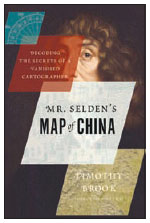A map with many secrets
Updated: 2013-10-31 11:39
By Kelly Chung Dawson in New York (China Daily USA)
|
||||||||
In popular history, early-17 th-century China is now recalled as an earthbound empire that had turned its back on both the water and the world. Early Chinese cartographers depicted China at the center, its surrounding bodies and waters skewed small to accommodate the essential. So when historian Timothy Brook was alerted to the discovery of a Chinese map from that era that envisioned the South China Sea at the crux of an elaborately illustrated network of criss-crossing ship routes, he understood the object’s potential to alter the way China is remembered.
In Mr. Selden's Map of China: Decoding the Secrets of a Vanished Cartographer, Brook guides readers through a history of cartography and globalization that begins—or ends--- with the first time he saw the map, which sat forgotten for close to a century in the basement of Oxford University’s Bodleian Library.
More than a meter wide and almost two meters long, the map presents an extraordinary panorama, richly patterned with vegetation and topography in the style of classical Chinese paintings. Ruler-straight lines trace the path of ships across the South China Sea, the first map in known history to present a world in which connections mattered more than the distances that separated nations.
 "The first lesson of map history is that maps are copies of other maps," Brook writes. "This wasn’t a copy of anything I knew… It was beautiful, it was unique: a historical document, a work of art and a mindscape of how someone once imagined the Asian world looked. Far more than a dry transcription of topographical facts, it animated an entire world. It was perfect."
"The first lesson of map history is that maps are copies of other maps," Brook writes. "This wasn’t a copy of anything I knew… It was beautiful, it was unique: a historical document, a work of art and a mindscape of how someone once imagined the Asian world looked. Far more than a dry transcription of topographical facts, it animated an entire world. It was perfect."
The provenance of the map remains unknown, but the man from whom it was bequeathed to Oxford’s Bodleian Library in 1659 may well be one of the most important individuals of the 17th century, Brook argues. John Selden, a lawyer, scholar and politician, studied Hebrew, Persian and Asian languages at a time when most dismissed the academic pursuit of other cultures, delving into an understanding of sovereignty and law from a global perspective that weighted cultures equally.
Selden pioneered the idea that nations could claim sovereignty of surrounding waters, arguing that his native Great Britain could claim jurisdiction over surrounding seas in the name of trade. As an early proponent of maritime law, his acquisition of what is now known as the "Selden Map" is particularly interesting. Although Selden left no record of his intentions or interest in the map, one can assume his interest lay in the object’s potential to explain the existing world.
"He was certain that every manuscript encoding Oriental knowledge had the potential to reveal world-changing knowledge, and should therefore be collected and preserved, even if no one could yet make sense of it," Brook writes.
Selden surely understood that the map represented a new system for viewing a rapidly globalizing network of nations. For Brook, the map meant a shift in the way he had looked at the supposedly isolated nature of early China. More than 100,000 Chinese left the country to work and trade elsewhere in 1630, he learned.
Brook’s scholarship of China has produced numerous books. His 2009 effort, Vermeer’s Hat, won the Mark Lynton History Prize from Columbia University.
 In Mr. Selden’s Map of China, Brook describes his early brush with the cultural power of maps. On a trip from China to Vietnam in 1976, a border guard confiscated a national atlas and a wall map of China. Displaying an attitude with roots in the Ming Dynasty, the guard judged the maps to have a bearing on national security.
In Mr. Selden’s Map of China, Brook describes his early brush with the cultural power of maps. On a trip from China to Vietnam in 1976, a border guard confiscated a national atlas and a wall map of China. Displaying an attitude with roots in the Ming Dynasty, the guard judged the maps to have a bearing on national security.
"A map did not merely represent China’s sovereignty; it was that sovereignty," Brooks writes of the experience. "For him, the map existed at a level of reality higher than the real world."
Even then, Brooks believed maps to be only as permanent as the paper they were printed on, he writes. His continued interest today lies in what maps can reveal about their creators and the circumstances under which one is created.
"My hope is that readers will come to see that what we don’t know about the past is absolutely endless," Brook said. "No longer can you write the history of England without its connections to China, and no longer can you write the history of China without an understanding of the rest of the world. An integrated global point of view matters more and more."
kdawson@chinadailyusa.com
(China Daily USA 10/31/2013 page2)

 Women fight to become China's next oceanauts
Women fight to become China's next oceanauts
 Two firms to debut in US at higher prices
Two firms to debut in US at higher prices History under a new light
History under a new light
 Kung fu master becomes hit online
Kung fu master becomes hit online
 Color-blind love
Color-blind love
 Lenovo's new secret weapon: Hollywood star
Lenovo's new secret weapon: Hollywood star
 Brussels visit heralds closer trade ties for EU and China
Brussels visit heralds closer trade ties for EU and China
 Halloween gaining popularity but still sees cultural differences
Halloween gaining popularity but still sees cultural differences
Most Viewed
Editor's Picks

|

|

|

|

|

|
Today's Top News
Freer RMB movement 'can answer US claims'
'Dangerous provocation' condemned
Ministry opposes disclosure of WTO report
Promoting baby formula prohibited in hospitals
Police told to protect medical workers
Celebrity ads under scrutiny
Man held after flights hit by false bomb threats
Vaccine gets nod for global use
US Weekly

|

|






